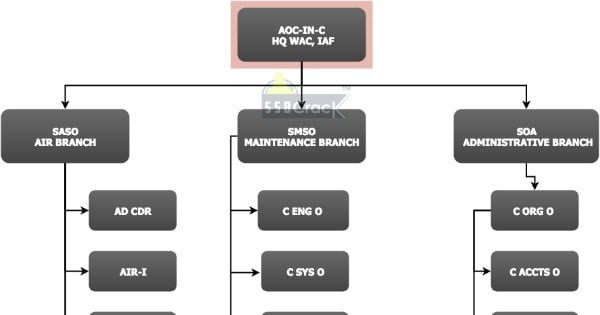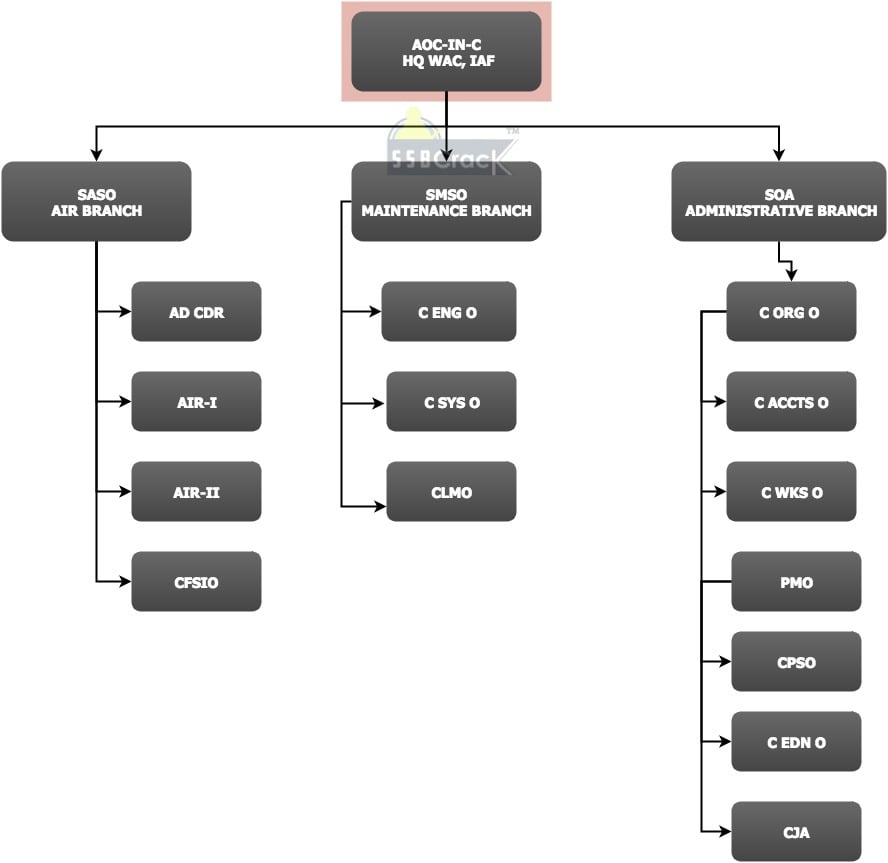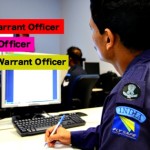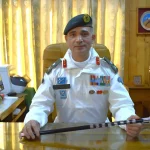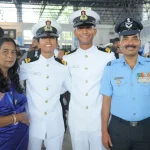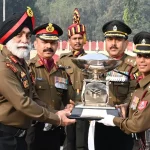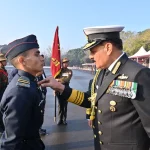Here is a chart of Indian Air Force complete structure which will help defence aspirants and defence lovers to understand how Indian air force works. IAF has three main divisions namely, Air branch, maintenene branch and administrative branch. You can also find the duties of each branch and commanding officer working in these branches.
DUTIES OF AIR BRANCH
SASO
- The SASO as head of Air Staff is responsible for maintaining operational preparedness of establishments under this Command at the highest level.
- He is responsible for conduct of all air operations undertaken by Western air Command, and will be reporting to Air Officer Commanding-in-Chief.
- As the head of the Air Staff he is responsible for Flight Safety and for supervision, direction and efficient functioning of the Air Branch.
- He is to maintain liaison with his counterpart in Northern, Western and South Western Command Army.
- He is to maintain close contact with ACAS (Ops) & SASO of CAC, EAC, SWAC, SAC and Training Command.
- Monitor progress of points raised during AOC-in-C’s, DASI and AEB visits.
AIR – I
- All fighter ops and its associated activity comes under Air-I, working directly under SASO, his primary functions are to control and direct the training and operational preparedness of Ground Attack Squadrons, Air Defence Squadrons and UAVs.
- Responsible for safe and efficient conduct of training of the above elements of WAC.
- Review the training syllabi and suggest to the SASO the necessary modifications and improvements for consideration by Air HQ.
- Conduct exercises to assess the operational capability of squadrons and to improve operational capability as a result of lessons learnt during operations and exercises.
- Assisting SASO in preparation of operational plans and instructions.
- Conducting fly pasts, demonstrations and weapons meet.
- The Air-I is also responsible to SASO for the efficient functioning of:-
- Command Electronics Warfare Section
- Command Computer Cell
- The Command Ops Room
- C NBC Section
- C UAV Section
- C PI Section
Air-II
- Responsible to SASO for all operational and training matters pertaining to transport aircraft and helicopters.
- Coordination and control of work done by Ops IIA, Ops IIB, C Nav O, C Met O and CATCO.
- To see that standardized operational training is provided in the Squadrons / Units and that suitable policy guidance and syllabi are made available to the Units.
- To scrutinize the operational efficiency of transport and helicopter units in order to meet operational tasks allotted to them.
- To ensure that required standard of flying discipline is maintained in the Units and check supervision of all aspects of this by the Wings concerned. To issue suitable instructions regarding testing handling and trials of aircraft in the various roles that they may be maximum efficiency.
- Development of transport and rotary wing aircraft tactics in their operational role plays an important part while training in peace time. Air II is to progress the development of such techniques to ensure maximum utilization of the potential available from the aircraft resources placed under WAC.
- Air II is responsible for controlling and coordinating VVIP/VIP flights within the jurisdiction of HQ WAC. He is also responsible to see that the training and operational status of the aircrew in Air HQ Comn Sqn is up to the standard desirable to meet Air HQ task.
AD Cdr
He is responsible to the AOC-in-C for the following:
- Effective planning and conduct of Air Defence operations, exercise of operational control over Air Defence elements assigned, attached or otherwise made available to him, and operational integration of all weapons systems into an effective fighting force.
- Recommending deployment of forces, weapons and Air Defence ground environment including augmentation of forces.
- Specifying tactics, procedures and methods for conduct of tactical air battle.
- Advising AOC-in-C of the operational capabilities and limitations of the air defence systems and forces that are under his operational control.
- Co-ordinating with the Command staff on matters on mutual interest which are the responsibility of the Command i.e. communications, maintenance aspects, logistic support and administration.
- Co-ordinating with Base Commanders for integration of Base Air Defence Concept (BADC).
CFS&IO
- To advise the AOC-in-C through SASO on Flight Safety policy and all other important matters affecting safety of flying operations.
- To ensure rapid and accurate reporting of all aircraft accidents, incidents and hazards.
- To initiate, implement and monitor Flight Safety programmes within the Command. To ensure dissemination of Air HQ Flight Safety policy to the units and its implementation.
- To ensure proper convening of Courts of Inquiry into aircraft accidents / incidents in accordance with laid down regulations.
- To analyse Operational Hazard Reports and initiate necessary preventive action.
- To carry out Flight Safety inspection / survey of flying stations and units at regular intervals.
DUTIES OF MAINTENANCE BRANCH
SMSO
He is responsible to Air Officer Commanding-in-Chief for all maintenance activities necessary to conduct air operations undertaken by Western Air Command. To this end he is responsible for: –
- Formulation of Maintenance Plans.
- Suggesting policy changes in maintenance philosophy.
- Ensuring availability of requisite number of aircraft and helicopters to meet peacetime and wartime tasks.
- Ensuring serviceability and availability of all Air Defence radars, airfield infrastructural facilities including airfield safety vehicles, arrester barriers, airfield lighting equipment, Radar and Radio Nav Aids and communications.
- Maintenance of all mechanical transport in the Command.
- Ensuring proper supply of clothing & FOL.
- Proper training and deployment of all technical personnel.
- Exercising financial power on behalf of AOC-in-C as per laid down instructions.
- Liaison with AOM’s branch and other branches at Air HQ to ensure that maintenance requirements of WAC are progressed.
- Liaison with other Commands, HAL and Civil agencies.
C Eng O
- Ensuring fleet operational effectiveness through monitoring and maintaining aircraft. Specialist aircraft support vehicles, ground handling equipment, Test eqpt and tools, serviceability at the required levels, during operations and in peace time.
- Monitoring availability of all aircraft role eqpt, armament ground handling equipment and aircraft modification status relating to weapon delivery capabilities to ensure weapon system effectiveness.
- Issuing servicing policy directives as well as translating Air HQ policy for meeting the aircraft maintenance requirements.
- Conducting aircraft maintenance workshops on major fleets for improving the technical knowledge of all technical officers and technicians through dissemination of knowledge on defect and diagnostic techniques.
- Preparation of quarterly Progress Report on all aircraft by 25 March, Jun, September and December and ensure submission of this return to SO-Coord (Maint).
- Closely monitoring DASI observations of various units and to initiate immediate actions to ensure that points are progressed.
- Ensure that general instructions on Quality Control of ATF, Hydraulic Discipline, Picketing and Marshalling of aircraft are issued and implemented by units.
C Sys O
The Command System Officer (C Sys O) is responsible to the SMSO for planning, installation, maintenance and servicing of all Air Defence Radars, Ground Signals Equipment including Radio and Radar Navigational Aids, Engineering Support, Ground Equipment including Aircraft Arrester Barriers and Airfield Lighting Systems, Armament and Safety Equipment, Photo Equipment, Simulators, Power Plants and Air Conditioning Systems and SAGW Equipment. He is also to exercise functional control of 73 RMU. He is to maintain close liaison with the Directorates of Ground Electronics, Engineering Support, Armament & Safety Equipment, Plan ADGES and GW maintenance at Air HQ for the procurement and allotment of the essential spares required by the units under WAC. He is to scrutinize the requirements of units in respect of wireless and electrical maintenance grants and control and distribution of these grants. He is responsible for installation and maintenance of all ground signals equipment including Air Defence Radars, Radio / Radar / Navigation aids such as NDB, V/UHF, DRDF / CADF, GCA, RSBN and R/T equipment.
CLMO
Command Logistics Management Officer is responsible to the SMSO for all logistic activities /functions which include supply of aircraft spares (Russian and NonRussian), support systems like ground equipment, signal and radar equipment, Technical and Logistics support for common user and specialist MT Vehicles. He is also responsible for smooth and uninterrupted supply of aviation fuel, POL items, compressed gas, ration, clothing and other non-technical stores. His duties also include interpretation of logistics policy, rules, regulations and procedures, approval of local service contracts, authorization of local purchase sanctions and progression of logistics Court Of Inquiry, store losses and audit objection. He is also coordinator of all rail / road and air movements for stores.
In addition, his duties are: –
- To ensure that all policy directives are made available to the units and are correctly interpreted by them.
- To check and confirm that the policies laid down are strictly implemented by all Stations / Units.
- To ensure that the units are provided with adequate resources for the task entrusted to them.
- To pay periodic staff visits to the units according to pre-planned programme and examine the entire organisation and functioning of the Logistics Section.
- To allocate clearly and precisely the responsibilities and duties of each officer and staff working under the CLMO and ensure their efficient functioning.
DUTIES OF ADMINISTRATIVE BRANCH
S O A
1. He is responsible to the AOC-in-C for efficient and effective administration of all units under WAC, efficient and effective administration of HQ WAC, effective personnel management for operational efficiency and high morale at all units under WAC, efficient financial management of Public and Non-public funds of HQ WAC and units under WAC and effective and judicious exercise of Financial powers vested in him by AOC-in-C or Air HQ or Govt of India as per laid down norms in AFOs, AFIs and Financial regulations.
2. He is to supervise the functioning of PMO, CPSO, C Accts O, C Wks O, C Org O, C Edn O and CJA of HQ WAC. His functions also include supervision of the functioning of CO HQ WAC (U) and ACE (Plg & L).
3. His other duties include: –
- Responsible for discipline in the Command.
- Visit to Units / Stations.
- Lay down targets and monitor progress of various administrative aspects.
- Monitor progress of Board of Officers for work services.
- Monitor progress in reduction of Cash / Railway Warrant audit objection.
- Follow up action on adm matters on reports of visits of CAS / AOC-in-C & DASI.
- Monitor and Co-ordinator welfare activities at units in WAC.
- Monitor and Co-ordinate activities of AFWWA in liaison with President AFWWA (R).
- Monitor functioning HQ WAC Officers’ Mess, Command Canteen and Command Press.
- Monitor & Co-ordinate sports activities at various units under the Command and at HQ WAC.
PMO
The PMO is the Medical Advisor to the AOC-in-C on all medical matters affecting the health of the personnel of the Western Air Command. This includes all matters affecting physical and mental efficiency of the officers, airmen and NCs(E) and the civilians in the Western Air Command. He is responsible for: –
- Control and administration of all medical and dental units / establishments in the Command through SOA. (b) Adviser to AOC-in-C through SOA on all aero-medical aspects of aviation and the care of flying personnel. He will advise on: – (a) Human factors of flight safety and accident prevention.
- Medical aspects of all Courts of Inquiry involving the Human factor.
- Disposal of cases of flying personnel who lose confidence to face up to flying duties.
- Control of Air Evacuation of Sick and Injured in war and peace.
- Medical and Hygiene aspects of all major works projects and sitting board.
- Provisioning of Red Cross Amenities to all units.
- Financial allotments to Stations /Wings Units under Conservancy and Hot Weather establishment, Office contingency for medical books / medical journals for hospitals / MI Room /SMC, Anti Malaria and Anti Fly Measures, Local purchase of Medical Stores.
He will exercise functional control of all AF Hospitals, Air Evacuation Units Teams of Medical Paratroopers Flight, all Air Force Dental Centres, All Maternity and Child Welfare Centres and Family Planning Centres.
CPSO
CPSO is to work under SOA and be responsible for all matters pertaining to P-1 & P-4. His duties are: –
- To ensure that the manning levels of officers, airmen and civilians in WAC is maintained in conformity with the general manning level in the Air Force. During emergency he is to ensure that additional manpower provided by Headquarters under augmentation plan is distributed to units under WAC based on the operational requirements.
- To ensure that highest standards of discipline, drill, parades and ceremonials are maintained at all units at all times.
- To provide necessary guidance to units in organizing welfare activities and is to ensure that the morale of personnel is kept at a high level.
- To ensure that security, ground defence and passive air defence organisations at units function to maximum efficiency and implement policies and directives issued by Air HQ / HQ WAC.
- To supervise working of the sections placed under him as per organisation chart and ensure that all policy letters, AFOs, AFIs are maintained up-to-date in the form of an ‘easy to refer’ compendium and the concerned personnel are fully conversant with them.
- To ensure that periodic visits to units are carried out by him / his officers to advise and guide the units on the spot, regarding personnel matters, security, ground defence and PAD and also to ascertain that the policies relating to these subjects are effectively implemented by them.
- He, as a Section Commander, is responsible for the layout, cleanliness and working environment of his Section, discipline, welfare and training of personnel working under him.
- He is responsible for ensuring security and proper maintenance of files and documents in the Sections placed under him.
C Edn O
- To advise AOC-in-C through SOA on all educational matters concerning the Command and all units placed under this Command.
- Direction, control and supervision of educational activities at all Stations / Units in the Command.
- To supervise and coordinate the implementation of the General Education Scheme at units under this Command.
- To administer allotment of Educational Grants placed at the disposal of the Command HQ in conformity with the provisions of Para 618 of P&A Regulations and AFO 6/2000.
- Supervision, organisation and administration of Reference and Technical Libraries, Information Rooms, Hobby Clubs and Study Rooms in Stations/Units in Stations/Units under this Command.
- Processing of applications for the following in-service examinations for officers, supervision of these examinations at specified centres:-
- Officers’ Promotion Examination
- DSSC (Air Wing) Entrance Examination
- Entrance Examination for Post Graduate Engineering Course
- Arrange for half yearly Hindi test for officers and airmen.
- Accounting of National Defence Fund Account and books purchased thereof and distribution of these books to units.
C Org O
- C Org O is responsible to SOA for the efficient management of the Organisation Section. He is to exercise the following financial powers on behalf of the AOC-in-C:-
- Authorise transfer of Establishment.
- Authorise printing of forms.
- Authorise local purchase of office contingency items, as applicable.
- Approve contracts in respect of conservancy services and book binding.
- Approve contracts of condiments.
- Authorise employment of casual labourers.
- Coordinate work connected with the conduct of Station Commanders’ Conference.
- Supervise revision of establishment, transfer of establishment, smooth functioning of URCs Catering services, updating of IAF Museum, introduction of clothing & heating appliances, general Adm aspect etc.
- Supervise the work of Command Fire Officer to ensure that Stations / Units have adequate fire fighting facilities and allied services.
C J A
Command Judge Advocate is the head of the Command Legal Section and is responsible to render legal advice on all matters pertaining to Air Force Law. The duties of Command Judge Advocate are as follows: –
- To give advice to the AOC-in-C through SOA on matters relating to Air Force Law such as:-
- Convening of GCM and DCM
- Summary disposal of charges against officers and Warrant Officers.
- Confirmation of proceedings of Courts Martial.
- To advise all the PSOs and the other sections of Command HQ and all AOsC, Stn Cdrs and COs.
- To examine summaries of evidence received in the section and render Reports on Applications for Trial in serious and complicated cases.
- To examine Court Martial Proceedings and render Reports on Trial.
- To examine and advise on petitions received in connection with Court Martial.
- To detail Judge Advocates at trials by Court Martial.
- To impart training to officers in the units on matters relating to AF Law, Summaries of Evidence, Court of Inquiry, Court Martial and Civil Suits.
- To supervise all civil suits filed in Supreme Court, High Courts, Lower Courts and Administrative Tribunals.
- To render advice on Statutory Applications.
- To examine Courts of Inquiry and advise on legal issues involved therein.
- To examine Delay Reports in respect of accused persons in custody beyond 8 days.
- To advise on disciplinary matters relating to Civilian employees.
- To advise on petitions of civilians under CCS (CC&A) Rules, 1965 and render advice to the appellate authority.
C Accts O
- Financial Advisor to AOC-in-C through SOA on accounting matters including administration and management of Non Public Funds held at Command HQ i.e. CWF.
- Operation of Command Imprest.
- Implementation of duties as Command Accounts Officer as laid down in rules and regulations.
- Budget – (i) Allotment/re-allotment/withdrawal of funds, compilation and reconciliation. (ii) Placement of demand of additional requirement of funds to Air HQ (D Fin P).
- Direction and control of accounting policy in Command.
- Checking of monthly & quarterly reconciliation of CDA(AF) with units.
- Authorise and countersign TA claims under various rules of TR. Sanction of Cash TA in respect of LTC for officers posted at HQ WAC and for AOC/Stn Cdr/CO/OC of Stations/Units under WAC.
- Sanction advance for purchase of Personal Computer/Motor Car/Motor Cycle/Moped. Approve applications for sale and extension of time limit.
- To sanction payment of credit balance in the AFPPF in case of an insane person etc.
C Wks O
- To maintain up to date information on works policy as laid down vide AFIs, AFOs, MES Publication, Standard Drawings etc and disseminate the same to units as required.
- To formulate annual works plan for various Stations in accordance with the priorities laid down.
- To advise the units on works policy and priorities mentioned as above. In addition, they should be kept informed regarding any temporary restrictions imposed / stipulations made by higher formations from time to time.
- To estimate the funds required for implementation of the yearly works plan and project the same to Air HQ well in time for budgetary allocation under various Code Heads.
- To maintain up to date information on the allocation of funds for Air Force Works to various Zonal Chief Engineers and to indicate the priorities according to which expenditure is to be incurred. The Chief Engineers should be advised to keep Command Works Officer informed of the expenditure incurred/funds committed.
- To ensure that the proceedings of all Board of Officers and Courts of Inquiry concerning works services are dealt with expeditiously and scrutinized carefully by his staff/SO I (Engrs) and specialist Section if required before submission to higher formations if need be.
Also Read: Indian Army Complete Structure Chart

